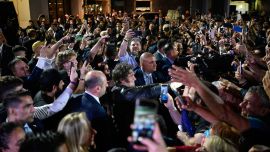Brazil’s Central Bank pledged to support its tumbling currency with all instruments and for as long as needed just as it stepped heavily into the spot market for the first time this year.
Monetary Policy Director Bruno Serra refrained from announcing a programme to systematically sell dollars from Brazil’s foreign reserves, but said this doesn’t mean the Central Bank is stepping out of the market any time soon.
“We will intervene for as long as needed,” he declared at a Bloomberg event in São Paulo, pledging to use all tools in the necessary amounts whenever it deems the foreign exchange market dysfunctional.
The real slid more than three percent to a fresh record of 4.78 per US dollar even after the Central Bank sold US$3 billion in a spot dollar auction. That’s three times the amount it had initially announced on Friday, when the currency was weakening on bets the Central Bank would further cut interest rates to shield the economy against the impact of the coronavirus epidemic.
Pressure on the real mounted on Monday after oil prices collapsed on international markets. The currency has lost more than 15 percent against the US dollar so far this year, making it the worst performing in the world and leading Economy Minister Paulo Guedes to call for serenity.
“The new Brazil has lower interest rates and a weaker currency,” he pointed.
Before Monday, the Central Bank had been stepping into the foreign exchange markets only via swap auctions, of which it sold US$9.5 billion in the past month in a bid to contain the volatility.
Rate cut
Disappointing economic figures and declining forecasts for growth this year are also weighing on Brazilian assets - especially the real, which is often used as hedge for long positions in stocks and rates.
The Central Bank signalled last Tuesday it will likely cut borrowing costs in its March 18 meeting, resuming the easing cycle markets had thought was over. The statement put extra pressure on the currency and led traders to fully price in a quarter-point rate cut.
Serra played down the idea of an emergency cut, saying the best place to decide on monetary policy is the Central Bank’s rate-setting meeting. Policy makers have other instruments available, he indicated, including mandatory reserve requirements and prudential regulation.
by Julia Leite, Bloomberg




















Comments